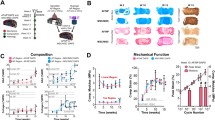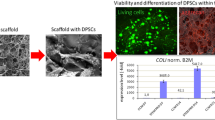Abstract
Due to their natural biochemical and biomechanical characteristics, using ex vivo tissues as platforms for guided tissue regeneration has become widely accepted, however subsequent attachment and integration of these constructs in vivo is often overlooked. A decellularized porcine temporomandibular joint (TMJ) disc has shown promise as a scaffold to guide disc regeneration and preliminary work has shown the efficacy of surfactant (SDS) treatment within the fibrocartilaginous disc to remove cellular components. The majority of studies focus on the intermediate region of the disc (or disc proper). Using this approach, inherent attachment tissues can be maintained to improve construct stability and integration within the joint. Unlike human disc attachment tissue, the porcine attachment tissues have high lipid content which would require a different processing approach to remove immunogenic components. In order to examine the effect of delipidation on the attachment tissue properties, SDS and two organic solvent mixtures (acetone/ethanol and chloroform/methanol) were compared. Lipid and cellular solubilization, ECM alteration, and seeded human mesenchymal stem cell (MSC) morphology and viability were assessed. Quantitative analysis showed SDS treatments did not effectively delipidate the attachment tissues and cytotoxicity was noted toward MSC in these regions. Acetone/ethanol removed cellular material but not all lipids, while chloroform/methanol removed all visible lipid deposits but residual porcine cells were observed in histological sections. When a combination of approaches was used, no residual lipid or cytotoxicity was noted. Preparing a whole TMJ graft with a combined approach has the potential to improve disc integration within the native joint environment.






Similar content being viewed by others
References
Willard VP, Arzi B, Athanasiou KA. The attachments of the temporomandibular joint disc: A biochemical and histological investigation. Arch Oral Biol. 2012;57:599–606.
Christo JE, Bennett S, Wilkinson TM, Townsend GC. Discal attachments of the human temporomandibular joint. Aust Dent J. 2005;50:152–60.
Merida-Velasco JR, Rodriguez JF, de la Cuadra C, Peces MD, Merida JA, Sanchez I. The posterior segment of the temporomandibular joint capsule and its anatomic relationship. J Oral Maxillofac Surg. 2007;65:30–3. United Statesp
Tanaka E, Detamore MS, Mercuri LG. Degenerative disorders of the temporomandibular joint: etiology, diagnosis, and treatment. J Dent Res. 2008;87:296–307. United Statesp
Heffez LB, Jordan SL. Superficial vascularity of temporomandibular joint retrodiskal tissue: an element of the internal derangement process. Cranio. 1992;10:180–91.
Matuska AM, Muller S, Dolwick MF, McFetridge PS. Biomechanical and biochemical outcomes of porcine temporomandibular joint disc deformation. Arch Oral Biol. 2016;64:72–9.
Dolwick MF. The role of temporomandibular joint surgery in the treatment of patients with internal derangement. Oral Surg Oral Med Oral Pathol Oral Radiol Endod. 1997;83:150–5.
Lumpkins SB, Pierre N, McFetridge PS. A mechanical evaluation of three decellularization methods in the design of a xenogeneic scaffold for tissue engineering the temporomandibular joint disc. Acta Biomater. 2008;4:808–16.
Matuska AM, McFetridge PS. The effect of terminal sterilization on structural and biophysical properties of a decellularized collagen-based scaffold; implications for stem cell adhesion. J Biomed Mater Res B Appl Biomater. 2015;103:397–406.
Matuska AM, McFetridge PS. Laser micro-ablation of fibrocartilage tissue: effects of tissue processing on porosity modification and mechanics. J Biomed Mater Res B Appl Biomater. 2018;106:1858–68.
Juran CM, Dolwick MF, McFetridge PS. Engineered microporosity: enhancing the early regenerative potential of decellularized temporomandibular joint discs. Tissue Eng Part A. 2015;21:829–39.
Herring SW. The dynamics of mastication in pigs. Arch Oral Biol. 1976;21:473–80.
Brown BN, Freund JM, Han L, Rubin JP, Reing JE, Jeffries EM, et al. Comparison of three methods for the derivation of a biologic scaffold composed of adipose tissue extracellular matrix. Tissue Eng Part C Methods. 2011;17:411–21.
Keane TJ, Londono R, Turner NJ, Badylak SF. Consequences of ineffective decellularization of biologic scaffolds on the host response. Biomaterials. 2012;33:1771–81.
Crapo PM, Gilbert TW, Badylak SF. An overview of tissue and whole organ decellularization processes. Biomaterials. 2011;32:3233–43.
van Meer G, Voelker DR, Feigenson GW. Membrane lipids: Where they are and how they behave. Nat Rev Mol Cell Biol. 2008;9:112–24.
Montoya CV, McFetridge PS. Preparation of ex vivo-based biomaterials using convective flow decellularization. Tissue Eng Part C Methods. 2009;15:191–200.
Moore M, Sarntinoranont M, McFetridge P. Mass transfer trends occurring in engineered ex vivo tissue scaffolds. J Biomed Mater Res A. 2012;100:2194–203.
Uzarski JS, Van De Walle AB, McFetridge PS. Preimplantation processing of ex vivo-derived vascular biomaterials: Effects on peripheral cell adhesion. J Biomed Mater Res A. 2013;101:123–31.
McFetridge PS, Daniel JW, Bodamyali T, Horrocks M, Chaudhuri JB. Preparation of porcine carotid arteries for vascular tissue engineering applications. J Biomed Mater Res A. 2004;70:224–34.
Prasertsung I, Kanokpanont S, Bunaprasert T, Thanakit V, Damrongsakkul S. Development of acellular dermis from porcine skin using periodic pressurized technique. J Biomed Mater Res B Appl Biomater. 2008;85:210–9.
Wolf MT, Daly KA, Reing JE, Badylak SF. Biologic scaffold composed of skeletal muscle extracellular matrix. Biomaterials. 2012;33:2916–25. England: 2012 Elsevier Ltdp.
Lakes EH, Matuska AM, McFetridge PS, Allen KD. Mechanical integrity of a decellularized and laser drilled medial meniscus. J Biomech Eng. 2016;138:4032381.
O’Brien J, Wilson I, Orton T, Pognan F. Investigation of the alamar blue (resazurin) fluorescent dye for the assessment of mammalian cell cytotoxicity. Eur J Biochem. 2000;267:5421–6.
Levy RJ, Vyavahare N, Ogle M, Ashworth P, Bianco R, Schoen FJ. Inhibition of cusp and aortic wall calcification in ethanol- and aluminum-treated bioprosthetic heart valves in sheep: Background, mechanisms, and synergism. J Heart Valve Dis. 2003;12:209–16. discussion 16
Dunmore-Buyze J, Boughner DR, Macris N, Vesely I. A comparison of macroscopic lipid content within porcine pulmonary and aortic valves. Implic bioprosthetic valves J Thorac Cardiovasc Surg. 1995;110:1756–61. United Statesp.
Vyavahare N, Hirsch D, Lerner E, Baskin JZ, Schoen FJ, Bianco R, et al. Prevention of bioprosthetic heart valve calcification by ethanol preincubation. Effic Mech Circ. 1997;95:479–88.
Jorge-Herrero E, Fernandez P, de la Torre N, Escudero C, Garcia-Paez JM, Bujan J, et al. Inhibition of the calcification of porcine valve tissue by selective lipid removal. Biomaterials. 1994;15:815–20.
Chappard D, Fressonnet C, Genty C, Basle MF, Rebel A. Fat in bone xenografts: Importance of the purification procedures on cleanliness, wettability and biocompatibility. Biomaterials. 1993;14:507–12.
Cebotari S, Tudorache I, Jaekel T, Hilfiker A, Dorfman S, Ternes W, et al. Detergent decellularization of heart valves for tissue engineering: toxicological effects of residual detergents on human endothelial cells. Artif Organs. 2010;34:206–10.
Reuber MD. Carcinogenicity of chloroform. Environ Health Perspect. 1979;31:171–82.
Acknowledgements
We gratefully acknowledge the support of the National Institute of Dental and Craniofacial Research at the US National Institutes of Health (NIH; 1R21DE022449) and the National Science Foundation Graduate Research Fellowship (DGE-1315138).
Author information
Authors and Affiliations
Corresponding author
Ethics declarations
Conflict of interest
The authors declare that they have no conflict of interest.
Rights and permissions
About this article
Cite this article
Matuska, A.M., Dolwick, M.F. & McFetridge, P.S. Approaches to improve integration and regeneration of an ex vivo derived temporomandibular joint disc scaffold with variable matrix composition. J Mater Sci: Mater Med 29, 152 (2018). https://doi.org/10.1007/s10856-018-6164-z
Received:
Accepted:
Published:
DOI: https://doi.org/10.1007/s10856-018-6164-z




